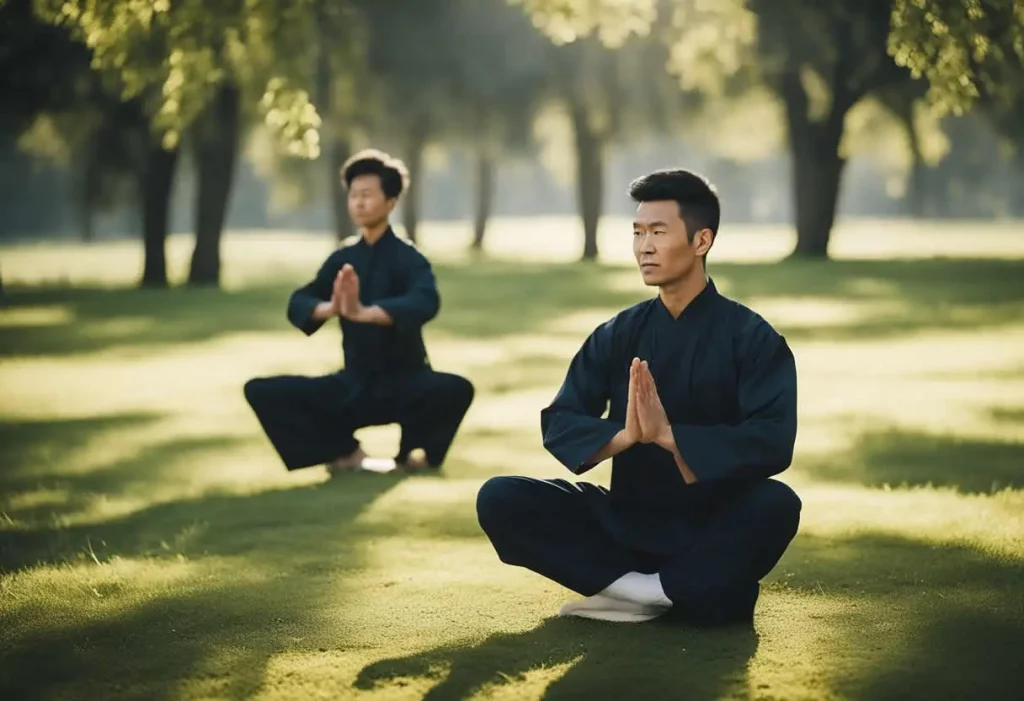When it comes to ancient Chinese traditions that promote wellness and mind-body connection, Tai Chi and Qi Gong are two popular options.
While they may share some similarities, it’s essential to understand the key difference between Tai Chi and Qi Gong.
Tai Chi, also known as Tai Chi Chuan, is a system of exercise and movement that originated as a martial art.
Today, it is widely practiced for its health and wellness benefits. Tai Chi involves slow and gentle motions, inspired by movements in nature. These flowing sequences offer numerous advantages for the body, mind, and spirit.
On the other hand, Qi Gong pronounced “chi gong,” is an internal practice that combines movement with intention and mindfulness to guide the flow of energy.
Considered the “internal” component of Tai Chi, Qi Gong focuses on stationary movements repeated to promote energy flow throughout the body. It can be used to enhance specific aspects of the mind, body, or spirit.

Content
What is the Main Difference Between Tai Chi and Qi Gong?
While both Tai Chi and Qi Gong offer valuable benefits, they differ in their approach. Tai Chi comprises a series of flowing movements that engage the entire body, whereas Qi Gong concentrates on specific movements that target particular issues or aspects.
It’s important to note that while Tai Chi might incorporate Qi Gong elements, not all Qi Gong practices will include Tai Chi movements.
Whether you’re considering Tai Chi or Qi Gong, it’s worth noting that both practices are adaptable for individuals of all fitness levels.
You don’t need to be in great shape or have prior experience to start practicing these ancient Chinese arts.
Both can be modified for seated practitioners or individuals with physical limitations. Plus, they can be practiced anywhere without the need for equipment.
Both Tai Chi and Qi Gong offer a myriad of health benefits, such as enhancing the immune system and relieving physical pain, anxiety, and stress.
So, if you’re looking to improve your overall well-being and find a pathway to a healthier mind and body, either Tai Chi or Qi Gong can be a wonderful choice.
What is Tai Chi?
Tai chi is a system of exercise and movement that was originally developed as a martial art. It is now widely used for health and wellness purposes.
The practice involves slow, gentle motions that are patterned after movements in nature. Tai chi offers numerous health benefits to the body, mind, and spirit, and can be practiced by almost anyone.
Tai chi is a holistic practice that combines physical movement, deep breathing, and meditation techniques. It is often described as a moving meditation, as it promotes a sense of relaxation and mindfulness.
The gentle, flowing movements of tai chi are designed to improve balance, flexibility, and strength. It also helps to reduce stress, enhance mental clarity, and promote overall well-being.
The practice is suitable for people of all ages and fitness levels, making it accessible to a wide range of individuals.
Through the practice of tai chi, you can improve your physical health, reduce the risk of falls and injuries, and enhance your mental and emotional well-being.
It can also help with managing chronic conditions such as arthritis, high blood pressure, and heart disease.
Overall, practicing tai chi regularly can lead to a greater sense of peace, vitality, and harmony within yourself. It is a gentle yet powerful practice that has stood the test of time and continues to offer numerous benefits to those who embrace it.
What is Qi Gong?
Qi gong pronounced “chi gong,” is an internal process that combines movement with intention and mindfulness to guide energy flow. Qi gong is often referred to as the “internal” portion of tai chi.
It involves stationary movements that are repeated a certain number of times and focus on the flow of energy throughout the body. Qi gong can be used to enhance specific aspects of the mind, body, or spirit.

The Difference Between Tai Chi and Qi Gong
While tai chi and qi gong share similarities, there are distinct differences between the two practices.
Tai chi involves a series of movements that work on the entire body in a flowing sequence. It is often referred to as “meditation in motion” due to its emphasis on mindfulness and graceful, continuous movements.
Tai chi is performed slowly and deliberately, promoting relaxation and balance.
On the other hand, qi gong focuses on specific movements that target a particular issue or aspect of the mind, body, or spirit.
It incorporates breath control, visualization, and energy cultivation techniques. Qi gong can be used to address specific health concerns or to maintain overall well-being.
While tai chi may incorporate elements of qi gong, not all qi gong practices will include tai chi movements.
It’s important to understand the goals and intentions behind each practice, as well as your own needs and preferences when deciding which one to pursue.
| Tai Chi | Qi Gong | |
|---|---|---|
| Main Focus | Full-body movements in a flowing sequence | Specific movements targeting mind, body, or spirit |
| Speed | Slow and deliberate | Varies; can be slow or dynamic |
| Intent | Relaxation, balance, and overall health | Addressing specific health concerns or maintaining well-being |
| Approach | Mindful, continuous movements | Combination of movement, breath control, and visualization |
Both tai chi and qi gong offer numerous health benefits and can be practiced by people of all fitness levels.
Exploring the similarities and differences between the two practices can help you determine which one aligns better with your own goals and needs.
Starting Tai Chi or Qi Gong
Both tai chi and qi gong are adaptable for individuals of all fitness levels. You do not need to be in great shape or have prior experience to begin practicing these ancient Chinese practices.
Tai chi and qi gong can be modified for seated practitioners or individuals with physical limitations. They can be practiced anywhere and do not require any equipment.
Both practices offer numerous health benefits, particularly for cancer survivors, by enhancing the immune system and relieving physical pain, anxiety, and stress.
If you’re new to tai chi or qi gong, here are some tips to get started:
- Look for a qualified instructor: It’s always helpful to learn from an experienced instructor who can guide you through the movements and provide proper instruction.
- Start with beginner-friendly classes: Many beginners find it helpful to start with beginner-friendly classes that introduce the basic principles and movements of tai chi or qi gong.
- Practice regularly: Consistency is key when it comes to tai chi and qi gong. Set aside a specific time each day or week to practice, even if it’s just for a few minutes.
- Listen to your body: Pay attention to how your body feels during the practice. If something feels uncomfortable or painful, adjust the movement or consult with your instructor.
- Stay present and mindful: Tai chi and qi gong are not just physical exercises but also practices that promote mental focus and mindfulness. Be present in the moment and engage all your senses.
Remember, tai chi and qi gong are practices that can be enjoyed by individuals of all ages and fitness levels.
Whether you’re looking to improve your physical health, reduce stress, or enhance your overall well-being, starting tai chi or qi gong can be a transformative journey.
Conclusion
Tai chi and qi gong are valuable practices that offer numerous benefits for promoting wellness and improving overall health.
Both practices have their unique characteristics, but they share similarities in their ability to enhance physical and mental well-being.
By incorporating tai chi or qi gong into your routine, you can experience improved balance, flexibility, and posture, reduced stress and anxiety, and increased energy levels.
Tai chi, with its flowing sequences of movements, provides a gentle yet effective workout for the entire body. It promotes relaxation, reduces inflammation, and improves cardiovascular health.
Qi gong, on the other hand, focuses on specific movements and intentions to guide energy flow and cultivate vitality. It enhances mental clarity, boosts the immune system, and promotes harmony within the body.
